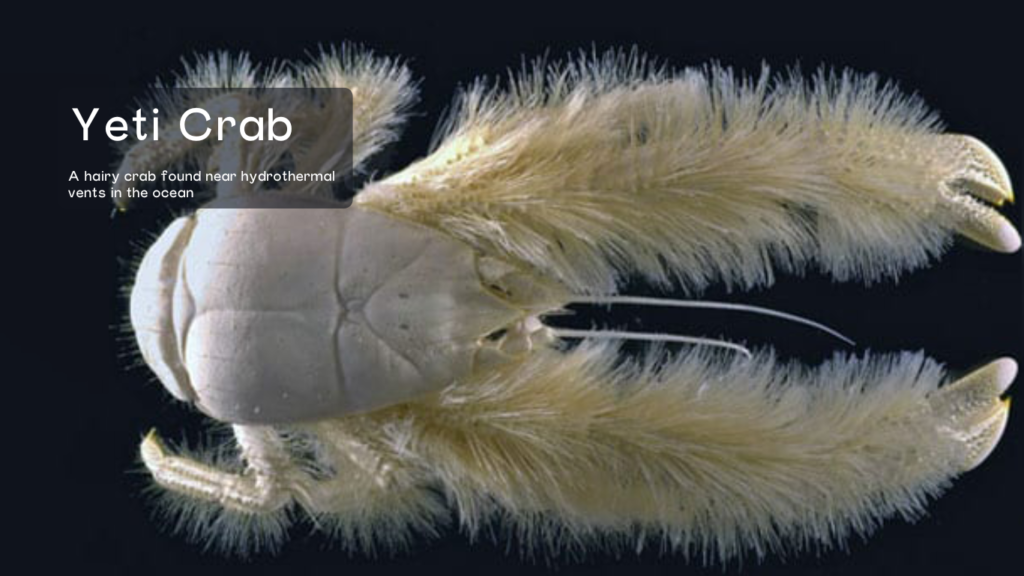The Yeti Crab: An Unusual Deep-Sea Creature
The Yeti Crab, scientifically known as Kiwa hirsuta, is a fascinating and rare crustacean that has captivated scientists and ocean enthusiasts since its discovery in 2005. Named for its furry, “yeti-like” appearance, this unique creature lives in some of the most extreme environments on Earth, thriving in areas with hydrothermal vents on the ocean floor. This article delves into the intriguing characteristics, behavior, habitat, and adaptations of the Yeti Crab, offering a comprehensive look at one of nature’s most mysterious animals.

Discovery and Classification
The Yeti Crab was first discovered by a team of marine biologists led by Dr. Michel Segonzac from the Monterey Bay Aquarium Research Institute during an expedition near the Pacific-Antarctic Ridge in the South Pacific Ocean. The crustacean’s distinctive appearance and unique habitat sparked widespread curiosity and a wave of new research.
The scientific name, Kiwa hirsuta, is derived from “Kiwa,” the mythological Polynesian goddess of shellfish, and “hirsuta,” meaning hairy in Latin. The Yeti Crab belongs to a new family of decapod crustaceans called Kiwaidae, named after the goddess. The creature’s unusual physical appearance, particularly its hairy, bristle-covered claws, has earned it the popular nickname “Yeti Crab,” drawing comparisons to the mythical Abominable Snowman of the Himalayas.
Physical Characteristics
The Yeti Crab stands out with its peculiar appearance, most notably because of the hair-like bristles (setae) that cover its claws and legs. These bristles are not simply for show; they are host to colonies of bacteria that play an essential role in the crab’s survival. The crab is generally pale or white, with a semi-translucent exoskeleton, which allows it to blend seamlessly with its deep-sea environment.
The crab has five pairs of legs, including the chelipeds (claws), which are the most conspicuous feature. Its entire body length is approximately 15 centimeters (around 6 inches), making it a medium-sized crab relative to other decapods. Due to the complete darkness of its habitat, the Yeti Crab has no functional eyes and is considered blind. This adaptation highlights its specialization for life in an environment where vision is not necessary.
Habitat: A Life by Hydrothermal Vents
One of the most intriguing aspects of the Yeti Crab is its choice of habitat. This crustacean lives exclusively around hydrothermal vents and cold seeps, areas where volcanic activity on the ocean floor releases mineral-rich fluids. These vents are located several thousand meters below the ocean’s surface, where temperatures range from near-freezing to over 400°C (752°F) in vent areas, though the crab stays in relatively moderate zones around the vents.
The presence of hydrothermal vents is crucial for the Yeti Crab, as the bacteria that grow on its hairy appendages are thought to derive nourishment from the minerals expelled by the vents. These deep-sea environments are challenging for most organisms due to extreme temperatures, high pressure, and a lack of sunlight. Yet, these vents support diverse ecosystems, with species relying on chemosynthesis rather than photosynthesis. The Yeti Crab is one of the many fascinating organisms that have adapted to thrive in these unique conditions.
Feeding Behavior and Symbiotic Relationship with Bacteria
The Yeti Crab has a highly specialized diet, relying on a symbiotic relationship with bacteria that grow on its hairy claws. These bacteria form a thick mat on the crab’s bristles and are believed to derive nutrients from the mineral-rich chemicals released by the hydrothermal vents. The crab “farms” the bacteria by waving its claws through the vent plumes, providing a steady stream of minerals to the bacteria, which in turn serve as a primary food source for the crab.
Studies suggest that the crab periodically consumes the bacteria it cultivates, making this symbiotic relationship a form of “farming” unique among known marine organisms. In addition to bacteria, the Yeti Crab may feed on detritus and small particles that drift around the vents. This unique feeding strategy allows it to thrive in an area where traditional food sources are virtually nonexistent, further demonstrating the crab’s remarkable adaptability to its extreme environment.
Adaptations to the Extreme Environment
Life in the deep sea requires numerous adaptations, and the Yeti Crab exhibits several to thrive in such an inhospitable environment. Its lack of functional eyes is one adaptation to the pitch-black world it inhabits, where eyesight is unnecessary. The crab instead relies on chemical and tactile senses to navigate and find food in the darkness.
The presence of bacteria on the crab’s claws is not only essential for its survival but also indicative of the crab’s unique approach to life in the extreme environment of hydrothermal vents. By cultivating and harvesting bacteria as a food source, the Yeti Crab demonstrates a remarkable form of mutualism, a survival strategy rare in marine life. Moreover, the Yeti Crab’s reduced pigmentation reflects an evolutionary response to the lack of sunlight, as coloration is unnecessary in its dark environment.
Another adaptation is its tolerance for extreme temperatures and high-pressure environments. The Yeti Crab resides near hydrothermal vents, where conditions can quickly shift from near-freezing to intensely hot, depending on proximity to the vent plume. The crab’s physiological adaptations allow it to survive in these fluctuating conditions, although it typically avoids the most extreme temperatures.
Reproduction and Life Cycle
Little is known about the reproductive habits of the Yeti Crab, given the difficulty of observing these creatures in their natural habitat. Like many deep-sea organisms, the Yeti Crab is likely to have a relatively slow reproduction rate and a long life cycle. Studies on related species in the Kiwaidae family suggest that reproduction may be seasonal and closely linked to environmental cues, such as changes in mineral flow from hydrothermal vents.
Female Yeti Crabs are believed to carry eggs in a brood chamber under their abdomen, protecting the young as they develop. Upon hatching, the larvae are thought to be planktonic, drifting in the open ocean before eventually settling near hydrothermal vents as they mature. However, specific details about their developmental stages remain unclear due to the challenges of studying these animals in situ.
Conservation Status and Future Research
As a relatively newly discovered species, the conservation status of the Yeti Crab has not been fully assessed. However, its limited habitat near hydrothermal vents makes it potentially vulnerable to environmental changes. Deep-sea mining and climate change could alter or destroy these delicate ecosystems, impacting not only the Yeti Crab but the entire vent community.
Continued research on the Yeti Crab is crucial for understanding the broader ecosystem dynamics of hydrothermal vent communities. As scientists continue to explore these areas, they may uncover more information about the biology, behavior, and ecological role of this enigmatic creature. Advances in deep-sea exploration technology will likely shed new light on the Yeti Crab’s life and lead to the discovery of other related species in the Kiwaidae family.
Conclusion
The Yeti Crab, with its furry claws and unique bacterial symbiosis, is a prime example of the adaptability of life on Earth. Thriving in one of the most extreme environments known, this crustacean reveals the resilience and resourcefulness of nature. As we continue to explore the mysteries of the deep sea, the Yeti Crab serves as a reminder of the many wonders that remain hidden in the ocean’s depths. Its discovery not only highlights the complexity of life on Earth but also emphasizes the importance of preserving our planet’s diverse ecosystems, even those far removed from human sight.
In many ways, the Yeti Crab is a symbol of the boundless adaptability of life, and as research continues, this mysterious creature may yield even more surprising insights into the secrets of the deep sea.








